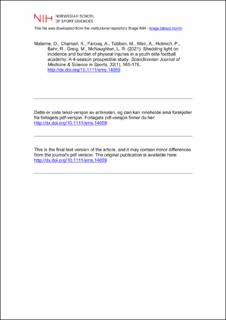| dc.contributor.author | Materne, Olivier | |
| dc.contributor.author | Chamari, Karim | |
| dc.contributor.author | Farooq, Abdulaziz | |
| dc.contributor.author | Tabben, Montassar | |
| dc.contributor.author | Weir, Adam | |
| dc.contributor.author | Holmich, Per | |
| dc.contributor.author | Bahr, Roald | |
| dc.contributor.author | Greig, Matt | |
| dc.contributor.author | McNaughton, Lars R. | |
| dc.date.accessioned | 2022-09-15T11:11:43Z | |
| dc.date.available | 2022-09-15T11:11:43Z | |
| dc.date.created | 2021-11-17T19:02:25Z | |
| dc.date.issued | 2021 | |
| dc.identifier.citation | Scandinavian Journal of Medicine & Science in Sports. 2021, 32(1), 165-176. | en_US |
| dc.identifier.issn | 0905-7188 | |
| dc.identifier.uri | https://hdl.handle.net/11250/3018022 | |
| dc.description | I Brage finner du siste tekst-versjon av artikkelen, og den kan inneholde ubetydelige forskjeller fra forlagets pdf-versjon. Forlagets pdf-versjon finner du på onlinelibrary.wiley.com / In Brage you'll find the final text version of the article, and it may contain insignificant differences from the journal's pdf version. The definitive version is available at onlinelibrary.wiley.com. | en_US |
| dc.description.abstract | Introduction: Physeal injuries have been overlooked in epidemiological research in youth sports. Our prospective study investigated the incidence, severity, and burden of physeal injuries in a youth elite football academy. Methods: In total, 551 youth male football players from under-9 to under-19 were included and observed over four consecutive seasons. Injuries involving the physis were diagnosed and recorded according to type, location, and diagnosis. Injury incidence (II), severity (days lost), and injury burden (IB) were calculated per squad per season (25 players/squad). Results: There were 307 physeal injuries: 262 apophyseal (85%), 26 physeal (9%), 2 epiphyseal (1%), and 17 other physeal injuries (5%) with 80% (n=245) causing time-loss. The overall mean incidence of time-loss physeal injuries was 6 injuries/squad-season, leading to a total of 157 days lost/squad-season. The U-16s had the highest burden with 444 days lost per squad-season [median: 20 (95% CI: 12–30) days; II: 10 (95% CI: 7.3.1–13.4)]. Apophyseal injuries of the hip–pelvis resulted in the greatest burden [median: 13 (95% CI: 10–17); II: 2.5 (95% CI: 2.1–3.0)]. Peak apophyseal injury incidence per body parts occurred in U-11 for foot–ankle (II: 2.4; 95% CI: 1.0–4.9), U-14 for knee (II: 4.5; 95% CI: 2.7–7.1), and U-17 for hip–pelvis (II: 6.4; 95% CI: 4.2–9.3). Conclusion: Physeal injuries accounted for a quarter of all-time loss with the largest injury burden in U-16. Most physeal injuries involved the lower limb and affected the apophysis. Physeal and apophyseal injuries incidence, burden, and pattern vary substantially depending on age. Hip–pelvic apophyseal injuries accounted for the largest injury burden. | en_US |
| dc.language.iso | eng | en_US |
| dc.subject | avulsion | en_US |
| dc.subject | epidemiology | en_US |
| dc.subject | growth plate | en_US |
| dc.subject | hip-pelvis apophysis | en_US |
| dc.subject | osteochondroses | en_US |
| dc.subject | pediatric | en_US |
| dc.subject | physis | en_US |
| dc.subject | soccer | en_US |
| dc.title | Shedding light on incidence and burden of physeal injuries in a youth elite football academy: A 4-season prospective study | en_US |
| dc.title.alternative | Shedding light on incidence and burden of physeal injuries in a youth elite football academy: A 4-season prospective study | en_US |
| dc.type | Peer reviewed | en_US |
| dc.type | Journal article | en_US |
| dc.description.version | acceptedVersion | en_US |
| dc.source.pagenumber | 165-176 | en_US |
| dc.source.volume | 32 | en_US |
| dc.source.journal | Scandinavian Journal of Medicine & Science in Sports | en_US |
| dc.source.issue | 1 | en_US |
| dc.identifier.doi | 10.1111/sms.14059 | |
| dc.identifier.cristin | 1955693 | |
| dc.description.localcode | Institutt for idrettsmedisinske fag / Department of Sports Medicine | en_US |
| cristin.ispublished | true | |
| cristin.fulltext | postprint | |
| cristin.qualitycode | 2 | |
